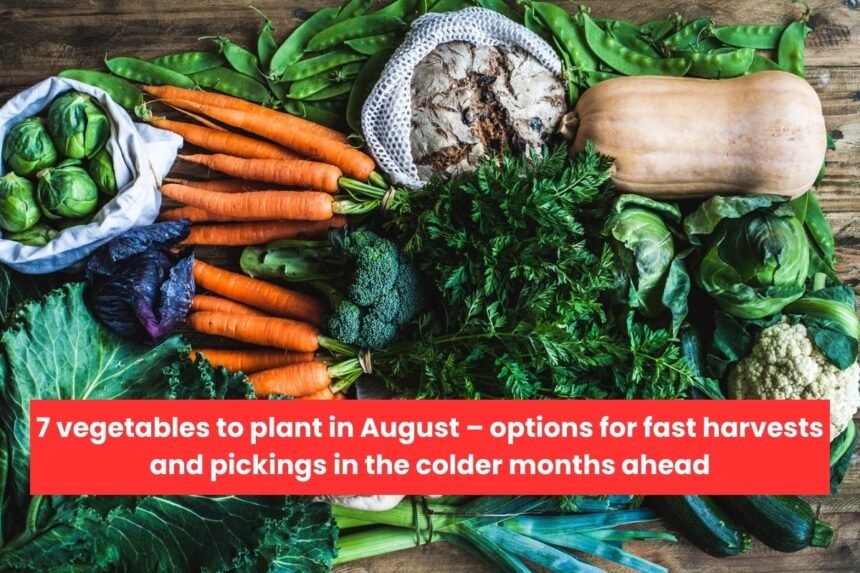You can grow vegetables all year long. While summer is a great time to harvest, it’s also a great time to plant more veggies so you can keep harvesting them for months to come.
As room opens up in the vegetable garden, it’s best to plant vegetables. When one crop is done, another is sown or planted to keep the plot very useful and makes sure that no ground is left empty for long.
You can plant some veggies that grow quickly in August to fill in gaps and get a crop quickly. Other vegetables grow more slowly but can give you homegrown food through the winter and into spring.
7 vegetables to plant in August
I had several kitchen gardens in the UK where I grew veggies all year, giving restaurants tasty food all year long. A lot of crops were being harvested in August, but it was still important to keep growing and sowing. Here are some of the best veggies to plant this month so that you can enjoy great homegrown meals all summer long.
1. Arugula
This month is a great time to plant arugula, rocket, roquette, or rucola. This famous and quickly growing vegetable goes by many names. To get spicy leaves for salads in the fall, plant arugula in August. If you use fleece or cloches to protect plants from frost, you can have them for longer.
If you plant this fast-growing plant, you might be able to gather the first arugula leaves in as little as one month. To gather, you can either pick individual leaves or cut the plant in half. If you treat it like a cut-and-come-again crop, the younger leaves in the middle of the plant will keep growing, giving you many bunches.
2. Chicory
The bitter leaves of chicory, also called endive, make it hard to get used to. Radish (also called red chicory), sugarloaf, and witloof (also called forced chicory) are the three types of chicory.
You can plant hardy kinds of chicory in August and eat them raw or cooked. Chicory varieties that don’t need to be fortified, like radicchio and sugarloaf, can be planted in the middle of summer to gather in the winter.
3. Corn salad
While August may be warm and sunny, it’s never too early to start planning to plant veggies that you can harvest in the fall and winter. That’s where leaves that can handle cold, like winter purslane and corn salad, shine.
Corn salad has leaves that taste like nuts, and the plants can survive in cold weather, so they can be picked all winter long, especially if you pick them as a cut-and-come-again crop by picking just the top leaves.
4. Green onions
These are green onions, which are grown for their mildly onion-flavored stems. They are also sometimes called spring onions or scallions. You can plant green onions in August and gather them in the spring.
For midsummer plantings that work, use cold-hardy types like “White Lisbon,” which you can get at Burpee, or plant the crop under cover to protect it from the winter. Spread the seeds out in holes that are 12 to 18 inches apart.
ALSO SEE;-Why aren’t my solar lights working 5 easy fixes, plus why your lights should always face south
5. Kohlrabi
Kohlrabi is easy to grow and can be eaten raw or cooked in many different ways. It is becoming more and more popular to grow this crop. These useless veggies are grown for their swollen stems, but they are also sometimes called bulbs. It takes about eight weeks from planting to harvesting.
Kohlrabi seeds can be planted at any time, from February to August. If you plant the seeds outside this month, you can gather the stems in October and November.
6. Lettuce
If you plant lettuce seeds in August, you can get leaves that you can use all through the fall and winter. You can get lettuce harvests well into the winter by planting lettuces that can handle cold weather over and over again. Plants will stay safe and produce salad leaves if you cover them with a cloche or horticultural fleece before the temperatures drop.
Plant seeds outside where they will grow, in an open area with fine, loose soil. You can also start lettuce seeds indoors instead, which will keep slugs and snails from eating the young as they grow. Growing lettuce in pots is a great way to get fall harvests on a deck, patio, or porch. It works well in beds and raised beds as well.
7. Radish
Radishes are a standard summer salad vegetable, and you can plant varieties that grow quickly starting in the spring. In August, you can plant radishes. This is the last chance to plant summer radishes and the best time to plant winter radishes.
Summer types that grow quickly, like the popular “French Breakfast,” can be ready 20 to 30 days after planting. Spread the seeds out in drills that are 4 to 6 inches deep and two inches apart.
Winter radishes, like “Black Spanish Round” and “Daikon,” get bigger. The drills should be spaced 12 inches apart, and the seeds should be spread out to six inches. Radish types A and B can be grown in pots or raised beds.
